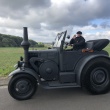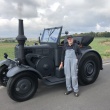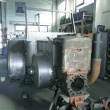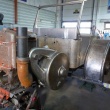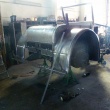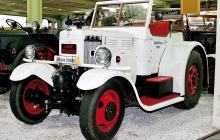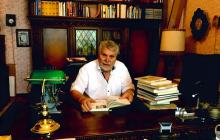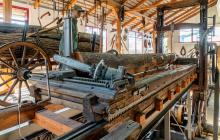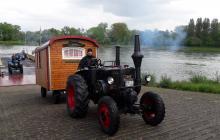The LANZ Bulldog has been in my life since I was 16 years old. Back then, my father gave me a 35 hp LANZ Ackerluft (“farmland air”) with a winch. I still own that one today and we have gone through a lot together. These machines have never stopped fascinating me. We even founded a LANZ Bulldog group that presents our LANZ Bulldogs to the visitors at the museum. If you are interested, please contact the events department and ask for Mr. Rausch.
The LANZ Speed-Bulldog is the company’s largest model. It used to be a road tractor with a maximum speed of 40 km/h. The vehicle has a five-speed transmission that can be changed down to crawling speed when driving with heavy loads. It has a 1-cylinder hot-bulb engine with 10 litres of displacement. The hot bulb has to be preheated with a blowtorch until it glows slightly – then the Diesel ignites. Since it is a two-stroke engine, it does not have any valves. Most of the Speed-Bulldogs were used in the military during the Second World War, either in the German Air Force or in the German Army. At least, there were all kinds of things for the Speed-Bulldog to pull back then: from aircrafts to searchlights, from searchlights to damaged tanks of the smallest type. Nowadays, people like to restore and mirror polish these tractors with brass-polished screws and gold leaf. However, I have a different taste, which is why the LANZ, that had once been mirror polished as well, was sent to the German military, i.e. it was disassembled and painted in the shade of grey that was used by the Wehrmacht, the unified armed forces of Nazi Germany. It is important for the paint to have a red base under it, to be very matte and to consist of synthetic resin. However, getting hold of synthetic resin paint was a difficult challenge. That is why I want to thank Rajko Crncec’s team of restorers for mixing the paint for me.

In the end, LANZ restorer Michael Schuth from Wallmerod in Westerwald was the one finishing the Bulldog for me. I got the idea of delivering the Speed-Bulldog on its own wheels during a visit at his workshop. Wallmerod is located 20 kilometres north of Limburg in Westerwald.
Now, we had to organise the trip. We had a 300 SL with gull-wing doors at our workshop at the time. It had not been driven for quite a while and had therefore deteriorated. The ignition could not be the problem – it was most probably the injection system because the engine showed some irregularities between a rotation speed of 3.5 and the maximum rotation speed and we were not 100 percent sure why. I thought, maybe a few kilometres on the highway might help. So, I asked my fellow student and museum member Bernd Eicker. He drove the gull-winged vehicle up to museum member Markus Kern. Markus Kern also lives in Westerwald. He restores and repairs supercharged cars by Mercedes. Over the years, we have developed a close friendship. Bernd had a look at the vehicle collection of the Kern family and went right back with the SL afterwards. The irregularities in the higher speed range had gotten a lot better. We hope that the technical issues will resolve completely when the car is driven more frequently in the future.
We had dinner with Markus and a few friends, spent a great night and I stayed overnight. The next day, Markus dropped me off in Wallmerod after a strong coffee in order to take over the LANZ. Thank you for that. It was exciting – I had the last details explained to me and then I took off with the LANZ toward Limburg. The first kilometres on the tractor felt very unusual to me, the federal highway had a lot of ruts which did not make the ride any easier. There was some traffic but it wasn’t uncomfortable. After passing Limburg, I drove in the direction of Camberg. Camberg is located 20 kilometres of Limburg. There, I left the federal highway at a crossing in a village called Esch in order to drive through the beautiful Emstal. The roads were deserted, the valley was beautiful, and there was a herd of around 100 sheep at the river. Since I drove up the Emstal, the LANZ was pretty loud and the sheep ran up the hill to the forest. Thank god I was gone quite quickly with the tractor. I was thinking about the poor shepherd who had to recapture his sheep afterwards. Please accept my apologies!

Afterwards, I drove toward Schmitten and then I started from Niederreifenberg to cross the Großer Feldberg. When driving uphill, the Bulldog is very loud so that I even had to cover my left ear in order to prevent my head from exploding. Luckily, I topped up the Bulldog with enough water because after some time, it started losing water. At the top of the Feldberg, it was very beautiful. The Bulldog had crawled up the hill in fourth gear. Obviously, that was pretty great. When driving an old car up a hill, you need to go down the hill in the same gear because of the brakes. So, we went down to Bad Homburg in fourth gear. While going downhill, I made a rookie mistake. The LANZ that I had been driving before did not have the so-called “Summerzündung” (jumping sparks ignition) this Bulldog had and you usually only need one of those if you want to start a tractor with petrol. However, I had only done that once before in my life and had given up on it afterwards due to my terrible experience with it. The last time I had started a tractor with petrol was when I was 16 years old. The LANZ then reaches the maximum rotation speed immediately. You have to install the steering wheel at the side of the Bulldog onto the crankshaft in order to start it. The parts were not lubricated and the steering wheel got stuck which resulted in quite a dangerous situation. However, an experienced LANZ driver would use the jumping sparks ignition downhill in order for the LANZ not to cool down. Fuel is injected during the overrun fuel cut-off and if it does not combust, the LANZ cools down. Unfortunately, I didn’t use this trick and therefore the Bulldog cooled down and I stranded 5 kilometres before arriving at Bad Homburg due to a cooled down hot bulb. So, I simply removed the blowtorch, flooded the blowtorch with fuel and then my problem began. Being a non-smoker, I did not have a lighter. So, I started stopping other cars and asked for help. Unfortunately, the first drivers I stopped were all non-smokers as well, so I decided to call museum member Philipp Dressel. Philipp runs the beautiful car museum “Central Garage” with his father in Bad Homburg (www.central-garage.de). He saved me by bringing me a lighter. So, I preheated the LANZ Speed-Bulldog and profited from its great luxury: the Bulldog has an electric starter! Afterwards, I continued my journey. While passing Oberursel, the Bulldog was still a little cold because we were in a hurry – it would have been better to have kept the blowtorch attached for another 5 minutes. Having reached the home of the Dressel family, I parked the LANZ and kept it going at a low rotation speed.
Suddenly, everyone was super excited. The Dressel family is conducting some agriculture as a hobby. A cow had been lying on the pasture and hadn’t moved for some time while the other cows were standing around it. Lo and behold, the cow had given birth to a healthy calf. Philipp called the veterinary in order to rub down the calf and see if everything was fine. Meanwhile, I ate some home-made salami from a Galloway cattle and drank a glass of apple cider. The calf is male and is now called Heinrich, named after Heinrich LANZ. When I mounted the tractor the newborn Heinrich was already trying to stand up, that was very nice.
I continued my journey southwards and suddenly found myself in the centre of Frankfurt at the Alte Oper (Old Opera). It was a beautiful sight. Unfortunately, the signposting in Frankfurt is not that good. How could I get out of Frankfurt again? I tried my best and still got lost hopelessly. Eventually, I ended up at the former Adler plant at the waterfront on the other side of the Main. Additionally, it started raining in the city and I had to put on a waterproof coat and hood. When the driver gets nervous, the LANZ Bulldog gets nervous as well. It only takes a low rotation speed in order to silently engage the third gear with which you start the vehicle. Imagine the following scenario: I was standing in line at a traffic light, I did not accelerate enough and thus stalled the engine, I stepped on the clutch in order to revive the LANZ and tried to start again and suddenly, the LANZ drove backwards! “Oh my god” – the engine was operating the other way around. So, I had to dismount from the Bulldog, open the side cover, close the injection pump, pump again at the right moment, change the operating direction of the engine and then continue my journey. At some point, I was on an arterial road without any exits and suddenly, I was standing in front of Terminal 2 of Frankfurt Airport.
Since the LANZ does not drive over 60 km/h, you are not allowed to drive on the highway. In Frankfurt, there were no signs, neither for Darmstadt, nor Neu-Isenburg, nor Offenbach. If I had had a lensatic compass, I could have determined the vague direction and could have theoretically driven in the right direction. Unfortunately, I did not have one of those. The people I asked for directions in Frankfurt were all very polite but as I said, suddenly, I found myself in front of Frankfurt Airport. There are no rural roads around there. The only possibility would have been to return to Frankfurt but I didn’t dare to do that and instead I chose to use the highway. I know that’s forbidden, but it was sheer self-defence! I covered the first part on the hard shoulder but after a while it stopped. Then, I was driving on the middle lane. With lorries on the left and cars coming from Würzburg on the right, the traffic was super fast and, to make matters worse, a landing plane was flying above me, so I thought in panic: “What the hell am I doing here?” Thank god it was the middle of the day and others could see me well.
Finally, I could take the exit and I went straight to Dreieich, hoping I would reach the federal highway 3 (B3) which would lead me directly to Heidelberg. The main railway line “Stuttgart-Frankfurt” crosses there. I had to wait forever at the boom gate and contacted museum member Thomas Kern who lives in Darmstadt. After the railway line came the B3. It felt wonderful. Finally, I knew how to get home. I had some canned sausage and a beer with Thomas Kern and then, the night fell. Thomas asked me to stay overnight but I had faith in the Bulldog and said that I would drive on. Thomas accompanied me a for a while in order to navigate me out of the town and then took a taxi home in the next town. Thank you for your help!
The B3 was pleasingly free, the night was fresh and dry, tractor and driver were exceptionally cheerful. Therefore, the ride passing Bensheim, Heppenheim, Hemsbach and Weinheim was very pleasant. In Heidelberg, I drove along the river Neckar on the side of the district Ziegelhausen, the view was amazing, the castle was beautifully illuminated. Passing the old bridge was a great delight. Probably, some people woke up from the noise since it was already quite late.
I could not pass Ziegelhausen without greeting museum member Kuno Hug, long-time CEO of Heidelberg Historic. Kuno lives in an enclosed courtyard. Just driving into the courtyard with the Bulldog was enough to attract Elisabeth Hug. However, Kuno was at a board meeting of the motorsport club. After a quick hug with Elisabeth and a short conversation, I continued my ride home. In Neckergemünd, I left the Neckartal and drove along the Elsenz in the direction of Sinsheim. The last elevation of the ride was the Krähbuckel in Mauer. This was very exciting. I was hoping to be able to cross the Krähbuckel in fifth gear, the highest gear, without changing down. At 3/4 of the elevation, the tractor started working hard. It produced some alarming sounds. Suddenly, there was a flame as thick as a thigh and with a length of about half a meter above the exhaust. With each piston slap the flame became 10 cm shorter just to become 10 cm longer right after. What a great experience to have in our beloved Kraichgau.
Sinsheim welcomed me warmly as I arrived at home at 11pm. After a short welcome, my wife told me not to touch anything and to take a bath right away. Probably, I was smelling of diesel and country road. Then, I drank two cups of cough and bronchial tea because it was only 7 degrees outside. Lying in bed, I could still hear the noises of the LANZ in my head.
All in all, it was an amazing experience. If you want to drive a LANZ, you need to put all the rush aside, relax, and drive calmly. This trains your mind and clears your head for new ideas. Another tip for all the adventurous drivers out there. My daughter reminded me of a strategy my father once had: had I stopped at the nearest taxi rank in Frankfurt and asked a taxi to drive ahead of me, my issue could have been resolved within half an hour and it would have been far less risky. This might help all of you who are driving cumbersome vehicles in a big city.
In general, I have noticed during my journey that our museum members are very well connected all over the world. They were the ones who made this LANZ adventure possible in the first place.
The stories and reports represent the opinions and perspectives of the respective authors. Please note, especially while reading articles about our events, that binding information (e.g. opening hours, admission fees and programme) is only published on the museum's official website www.technik-museum.de.
Please note that the pictures, texts and videos published here are subject to the copyright of the respective authors and / or the museum and may not be used without permission.
Keep up-to-date with new articles
We recommend to subscribe to the museum’s newsletter via e-mail. At the end of each newsletter, we inform you about new articles so that you will not miss any of them. Alternatively, you can subscribe to an RSS feed:
Subscribe to newsletter RSS-Feed (Reader required)

